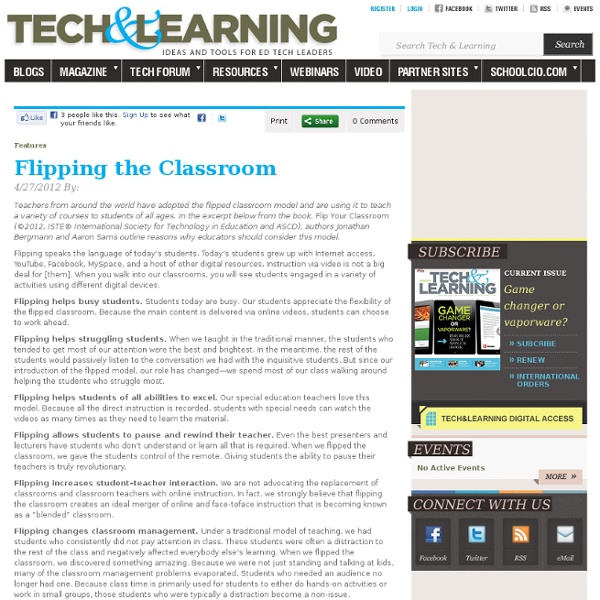Flipping the Classroom

Flipped Classroom - Savage Science
Who Said Lecture is Dead? Flipping the Traditional Classroom Model By Craig Savage I’ll let you in on a little secret: Teachers love to lecture. Okay, that’s probably not such a big secret. Just listen to one of my students: “Savage loves to hear himself talk. The fact is, lecture is a very efficient way for teachers to move through the material they think is important, in the order they think is important, at the pace they think is appropriate. However, in this time of educational reform (has there ever been a time when we weren’t reforming education?) But lecture isn’t dead. However, the larger question remains: Does lecture still belong in the classroom? For me personally the questions are: What is my value in the classroom? “The sage on the stage” model (a style in which I was able to thrive as a student and a style I believe I have mastered as a teacher) represents a one-way flow of information that fails to capitalize on the social opportunities of a classroom.
Flip Your Classroom - Get Your Students to Do the Work
Recently I shared lunch with colleague and friend, Mike Gwaltney. He teaches in a variety of blending settings both in class and online. We got into an interesting discussion about ways to deliver instructional content and learning process both in and outside the classroom. The conversation quickly turned to the notion of "flipping the classroom." This is the idea that teachers shoot videos of their lessons, then make them available online for students to view at home. Watch this video to see flipping in action - cool graphics courtesy of Camtasia Studio. Both of us admired teachers (like these in the video) with the time, technology and talent to do video productions - but questioned how many teachers would be able to morph into video producers. Flip the delivery of the lesson to homework - it's like a TiVo time shift that can reshape your classroom. Ultimately, we saw flipping the class as a great opportunity to engage our students in taking more responsibility for their learning. 1.
Why I Gave Up Flipped Instruction
A little over a year ago I wrote a post about the flipped classroom, why I loved it, and how I used it. I have to admit, the flip wasn’t the same economic and political entity then that it is now. And in some ways, I think that matters. Here’s the thing. When I recently re-read the post, I didn’t disagree with anything I’d said. When I wrote that post, I imagined the flip as a stepping stone to a fully realized inquiry/PBL classroom. What is the flip? The flipped classroom essentially reverses traditional teaching. When I first encountered the flip, it seemed like a viable way to help deal with the large and sometimes burdensome amount of content included in my senior Biology & Chemistry curricula. My flipped experiments I first encountered the flip in a blog post. My students loved the idea of trying something that very few other students were doing. We began to shift What was my role? The flip faded away As this shift occurred, the flip simply disappeared from our classroom. No.
Creating learning objectives, flipped classroom style - Casting Out Nines
In my last post about the inverted/flipped calculus class, I stressed the importance of Guided Practice as a way of structuring students’ pre-class activities and as a means of teaching self-regulated learning behaviors. I mentioned there was one important difference between the way I described Guided Practice and the way I’ve described it before, and it focuses on the learning objectives. A clear set of learning objectives is at the heart of any successful learning experience, and it’s an essential ingredient for self-regulated learning since self-regulating learners have a clear set of criteria against which to judge their learning progress. And yet, many instructors – myself included in the early years of my career – never map out learning objectives either for themselves or for their students. Or, they do, and they’re so mushy that they can’t be measured – like any so-called objective beginning with the words “understand” or “appreciate”. We’re not done with this list.
Related:
Related:



